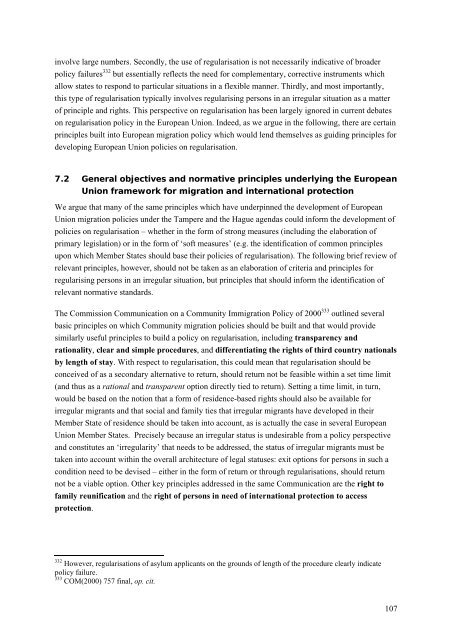REGINE Regularisations in Europe Final Report - European ...
REGINE Regularisations in Europe Final Report - European ...
REGINE Regularisations in Europe Final Report - European ...
Create successful ePaper yourself
Turn your PDF publications into a flip-book with our unique Google optimized e-Paper software.
<strong>in</strong>volve large numbers. Secondly, the use of regularisation is not necessarily <strong>in</strong>dicative of broader<br />
policy failures 332 but essentially reflects the need for complementary, corrective <strong>in</strong>struments which<br />
allow states to respond to particular situations <strong>in</strong> a flexible manner. Thirdly, and most importantly,<br />
this type of regularisation typically <strong>in</strong>volves regularis<strong>in</strong>g persons <strong>in</strong> an irregular situation as a matter<br />
of pr<strong>in</strong>ciple and rights. This perspective on regularisation has been largely ignored <strong>in</strong> current debates<br />
on regularisation policy <strong>in</strong> the <strong>Europe</strong>an Union. Indeed, as we argue <strong>in</strong> the follow<strong>in</strong>g, there are certa<strong>in</strong><br />
pr<strong>in</strong>ciples built <strong>in</strong>to <strong>Europe</strong>an migration policy which would lend themselves as guid<strong>in</strong>g pr<strong>in</strong>ciples for<br />
develop<strong>in</strong>g <strong>Europe</strong>an Union policies on regularisation.<br />
7.2 General objectives and normative pr<strong>in</strong>ciples underly<strong>in</strong>g the <strong>Europe</strong>an<br />
Union framework for migration and <strong>in</strong>ternational protection<br />
We argue that many of the same pr<strong>in</strong>ciples which have underp<strong>in</strong>ned the development of <strong>Europe</strong>an<br />
Union migration policies under the Tampere and the Hague agendas could <strong>in</strong>form the development of<br />
policies on regularisation – whether <strong>in</strong> the form of strong measures (<strong>in</strong>clud<strong>in</strong>g the elaboration of<br />
primary legislation) or <strong>in</strong> the form of ‘soft measures’ (e.g. the identification of common pr<strong>in</strong>ciples<br />
upon which Member States should base their policies of regularisation). The follow<strong>in</strong>g brief review of<br />
relevant pr<strong>in</strong>ciples, however, should not be taken as an elaboration of criteria and pr<strong>in</strong>ciples for<br />
regularis<strong>in</strong>g persons <strong>in</strong> an irregular situation, but pr<strong>in</strong>ciples that should <strong>in</strong>form the identification of<br />
relevant normative standards.<br />
The Commission Communication on a Community Immigration Policy of 2000 333 outl<strong>in</strong>ed several<br />
basic pr<strong>in</strong>ciples on which Community migration policies should be built and that would provide<br />
similarly useful pr<strong>in</strong>ciples to build a policy on regularisation, <strong>in</strong>clud<strong>in</strong>g transparency and<br />
rationality, clear and simple procedures, and differentiat<strong>in</strong>g the rights of third country nationals<br />
by length of stay. With respect to regularisation, this could mean that regularisation should be<br />
conceived of as a secondary alternative to return, should return not be feasible with<strong>in</strong> a set time limit<br />
(and thus as a rational and transparent option directly tied to return). Sett<strong>in</strong>g a time limit, <strong>in</strong> turn,<br />
would be based on the notion that a form of residence-based rights should also be available for<br />
irregular migrants and that social and family ties that irregular migrants have developed <strong>in</strong> their<br />
Member State of residence should be taken <strong>in</strong>to account, as is actually the case <strong>in</strong> several <strong>Europe</strong>an<br />
Union Member States. Precisely because an irregular status is undesirable from a policy perspective<br />
and constitutes an ‘irregularity’ that needs to be addressed, the status of irregular migrants must be<br />
taken <strong>in</strong>to account with<strong>in</strong> the overall architecture of legal statuses: exit options for persons <strong>in</strong> such a<br />
condition need to be devised – either <strong>in</strong> the form of return or through regularisations, should return<br />
not be a viable option. Other key pr<strong>in</strong>ciples addressed <strong>in</strong> the same Communication are the right to<br />
family reunification and the right of persons <strong>in</strong> need of <strong>in</strong>ternational protection to access<br />
protection.<br />
332 However, regularisations of asylum applicants on the grounds of length of the procedure clearly <strong>in</strong>dicate<br />
policy failure.<br />
333 COM(2000) 757 f<strong>in</strong>al, op. cit.<br />
107
















